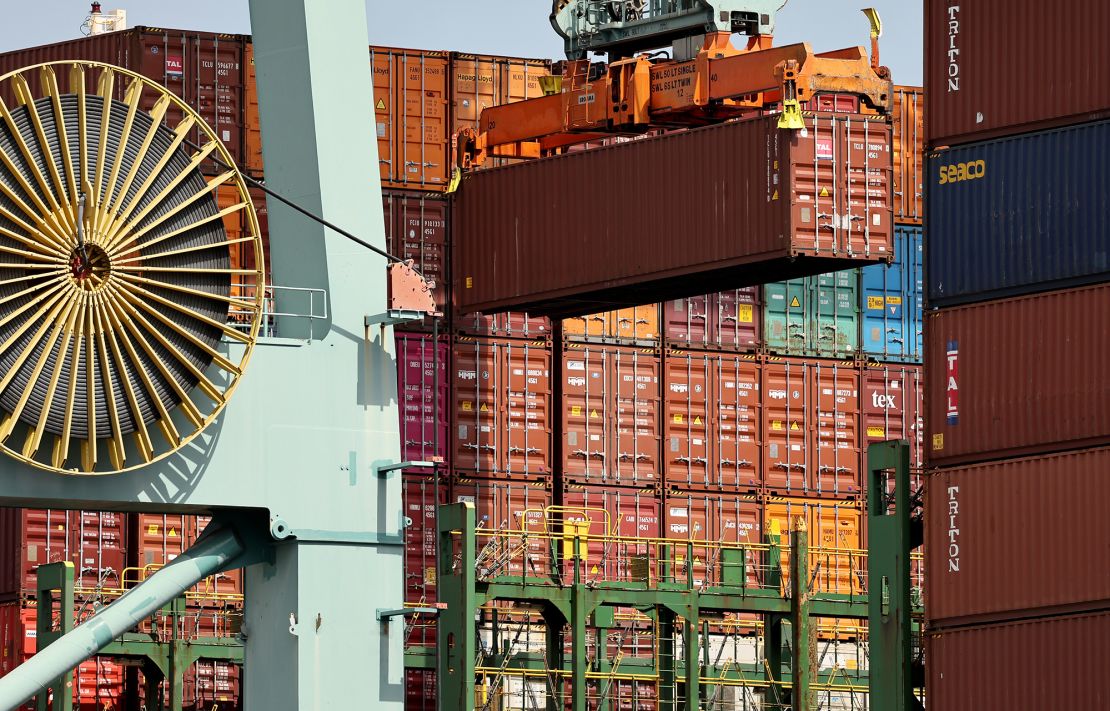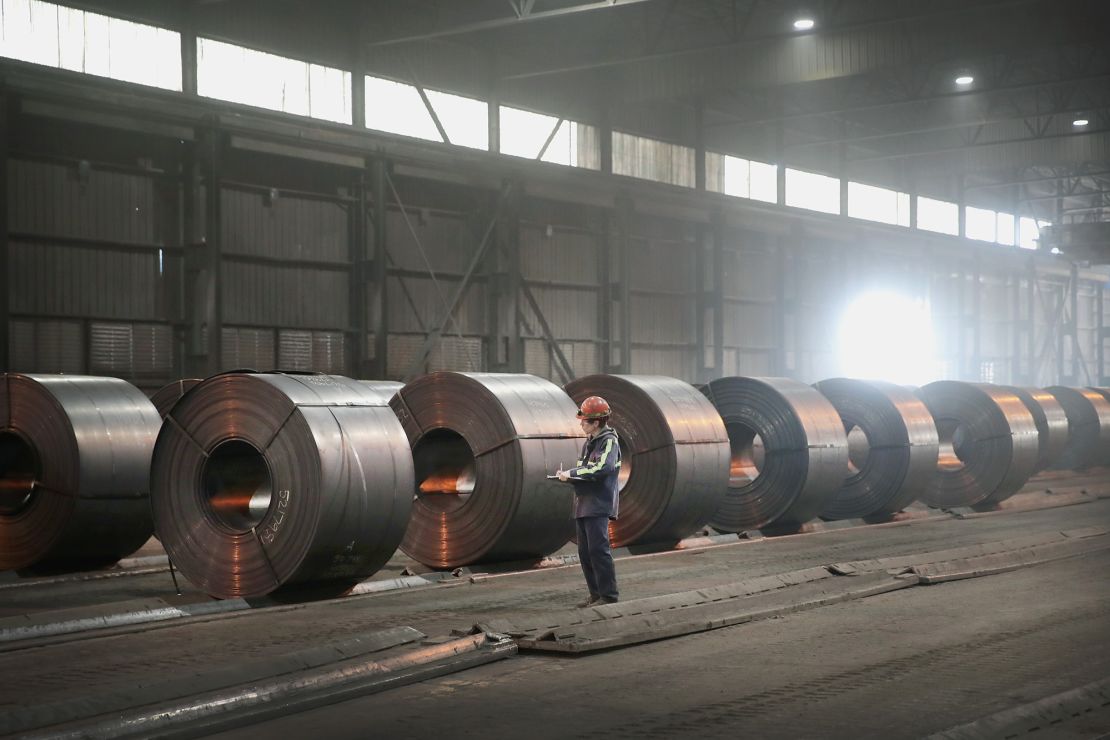London
CNN
—
When the United States hiked tariffs on most goods entering the country almost a century ago, the consequences were severe: global trade plummeted and US exports collapsed, as other countries retaliated in kind, deepening one of the world’s worst ever economic downturns — the Great Depression.
The tariffs in question, levied under the Smoot-Hawley Tariff Act of 1930, would be dwarfed by the duties that Donald Trump has pledged to impose if he wins a second term in the White House.
Alongside other radical ideas — including mass deportations of undocumented immigrants and interfering with the independence of the Federal Reserve — Trump has said he wants to slap 10-20% tariffs on all goods imported into the United States. That would be sharply up from the current average of 2% on non-agricultural, or so-called industrial, goods, half of which enter the US duty-free, according to the government.
For Chinese imports, Trump has proposed an even steeper 60% tariff.
“To me, the most beautiful word in the dictionary is ‘tariff.’ It’s my favorite word,” he said during an interview with Bloomberg last week at the Economic Club of Chicago.
Most economists do not share Trump’s fondness for tariffs because they act as a tax on imports, hurting consumers in the country imposing them, as well as businesses that rely on imported raw materials and intermediate goods to make finished products.
Many economists have warned that tariffs planned by Trump will hurt global economic growth and drive up inflation in the US, as well as abroad if other countries introduce higher levies on US imports in response.
Going ahead with the higher tariffs “would antagonize US allies and partners, provoking worldwide trade wars, damaging global economic welfare and undermining national security,” researchers from the Washington, DC-based Peterson Institute for International Economics wrote in a recent note.
While predictions of the damage from Trump’s new tariffs vary in scale and scope — depending on the level of the levies and any retaliatory tariffs from America’s trade partners — forecasters are overwhelmingly negative.
For example, analysts at UBS estimate that a 60% tariff on imports from China and a 10% tariff on goods from the rest of the world would lower global economic growth by one percentage point in 2026, when the tariff hikes are likely to have been fully implemented. That would cut growth by almost a third, based on current trends.
Company profits would on average fall by 6% and global stock indexes would also drop, with particularly sharp declines in European, Chinese and other emerging market equities, according to UBS. That could eat into people’s pension pots and other invested savings.
Europe’s economy would suffer a sizeable blow. If the US hikes tariffs to 10% on all goods, the damage to the gross domestic product of the eurozone — the 20 countries that use the euro — would be akin to that from the energy crisis sparked by Russia’s invasion of Ukraine in 2022, according to ABN AMRO. The economy narrowly avoided a recession in the aftermath, and the Dutch bank forecasts stagnation in 2026 as a result of the tariffs.
The International Monetary Fund also sees a hit to global output from potential higher tariffs around the world, its latest World Economic Outlook showed earlier this week.
According to an IMF analysis published last year, in a “severe scenario” of widespread tariff increases and trade restrictions, global output could plunge by 7% over the longer term. That would amount to a reduction roughly equal in size to the combined annual GDP of Germany and Japan, the agency said at the time.
“Assuming (Trump) goes ahead with what he’s proposing, nobody comes out unscathed,” Maurice Obstfeld, a senior fellow at the Peterson Institute and former chief economist at the IMF, told CNN.
In Chicago last week, Trump, who styles himself as a hard-headed business mogul, boasted about getting tough on allies — including Japan, France and South Korea — through tariffs, or simply the threat of tariffs, during his first term as president.
If he returns to the White House, his winner-take-all approach to trade relations would further undermine the principles of open trade and competition that have powered global economic growth for decades.
In the last 40 years, when trade as a share of global GDP increased by half, inflation-adjusted income per head has doubled and more than a billion people emerged from extreme poverty, Kristalina Georgieva, the head of the IMF, wrote earlier this year.
“It’s true that not everyone benefited from trade, which is why we must do more to ensure the gains are shared fairly. But to close off our economies would be a mistake,” she said.

A rise in protectionism around the world means open trade is already under threat and the ability of its champion, the World Trade Organization, to settle international trade disputes is severely constrained.
Trump’s approach would lead to “a global trading system that is a patchwork of bilateral deals,” Obstfeld said. “How that system would function is anyone’s guess, but it’s a good guess that we would see less trade, the gains from trade would be reduced and that trade relations between countries would remain more fractious than they have (been) in the past.”
Petros Mavroidis, a professor at Columbia Law School and long-time legal adviser to the WTO, sees an even bleaker outcome.
“I think it’s unrealistic, if we go by world history, to think we can have segmented trade but world peace,” he told CNN. “The world has to be connected both economically and non-economically. If it’s not connected, then you pay the price.”
Other countries will likely not only impose retaliatory tariffs on US imports but also introduce tariffs on imports from elsewhere to protect their markets from the flood of goods that would otherwise have gone to the US.

When Trump announced tariffs on steel and aluminum imports in March 2018, the European Union followed with its own duties on certain steel products four months later, citing the risk of higher imports. It also hit back directly at its transatlantic ally with duties on more than $3 billion worth of US goods, including motorcycles, denim and whiskey.
More recently, the EU has hiked tariffs on electric vehicles from China, a move analysts say was partly aimed at preventing a torrent of EV imports after US President Joe Biden slapped 100% tariffs on Chinese EVs.
“You can get into a spiral of trade measures, initiated by the US but then amplified by other countries,” said André Sapir, a senior fellow at Bruegel, a think tank in Brussels.
Besides tariffs, economists are also vexed by Trump’s desire to exert more control over the Federal Reserve.
While he avoided answering a direct question from Bloomberg on whether he would remove Fed chair Jerome Powell, whose term ends in May 2026, he has threatened it once before because Powell was “keeping the rates too high.”
“I think I have the right to say, ‘I think you should go up or down a little bit,’” Trump said in Chicago. “I don’t think I should be allowed to order it but I think I have the right to put in comments as to whether or not interest rates should go up or down.”
Any attempt to weaken the Fed’s independence, viewed as sacrosanct by investors, would rattle global financial markets and have a destabilizing effect on the dollar, the world’s leading currency for trade invoicing and foreign exchange reserves.
That’s because investors would doubt whether a compromised Fed can effectively combat high inflation, which generally weakens a currency and can hurt economic growth if left unchecked.
“If you move the Fed to some sort of political control, that’s going to really change the rules of global finance,” said Obstfeld, adding that there was “no good substitute” for the greenback and therefore messing with it was “a bad plan.”
Edward Alden, a senior fellow at the Washington, DC-based Council on Foreign Relations, a foreign policy think tank, thinks it unlikely that Trump will interfere with the Fed’s independence, given the risks such a move poses to the US economy.
Still, his actions during a second presidential term are likely to be more extreme than during his first stint in the White House, when “there was an active group of more conventional Republicans working very hard to keep Trump from doing crazy things,” he told CNN.
“None of those people are going to have a job in the second administration.” Nor will a possible reelection bid constrain him, since a US president can only serve two terms, he noted.
Trump “is going to be much more unbound and he has a much better sense of how to work the bureaucracy to get his way,” Alden added. “What we’d see in Trump 2 is far more radical than what we saw in Trump 1.”
